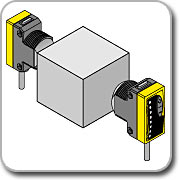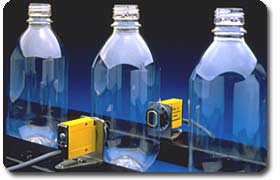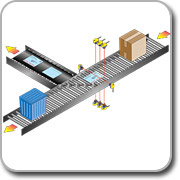|

How it Works:
In opposed-mode sensing, the sensor's emitter and receiver are
housed in two separate units. The emitter is placed opposite the
receiver, so that the light beam goes directly from the emitter to
the receiver. An object is detected when it breaks the working part
of the light beam, known as the effective beam. |
 |
|
Pros: Reliability
The opposed mode should be
used whenever possible, because it is the most reliable sensing
mode. This is because light passes directly from the emitter to the
receiver. Opposed-mode sensing offers the highest level of sensing
energy to overcome both contamination in
the environment and possible sensor misalignment from shock and
vibration
Pros:
High Excess Gain
Because the light beam goes directly from the emitter to the
receiver, this means that opposed-mode sensors have high excess
gain. Opposed-mode sensing offers much higher excess gain (the
measurement of the amount of light falling on the receiver of a
sensing system over and above the minimum amount of light required
to just operate the sensorís amplifier) than any other mode of
sensing, making them ideal in areas of high optical attenuation
(Lessening or loss of signal intensity during transmission).
High excess gain is great for applications that need:
-
Long range
sensing
-
Sensing
through heavy dirt, dust, mist, condensation, oil, film, etc.
-
Precise
position sensing
-
Small part
detection using lens apertures (the aperture refers to the size
of a lens opening which can sometimes be reduced by using a
mechanical part attached to a lens used to restrict the size of
the opening)
Pros: Impervious to Surface
Reflectivity*
It doesn't matter how
shiny or dark your object is, or even what color. The object must
physically pass between the emitter and the receiver in order to be
detected. Therefore, variables such as surface reflectivity, color,
and finish don't affect opposed-mode sensing. The object either
"breaks" or interrupts the effective beam, or it doesn't.
*Surface Reflectivity: A measure of
the efficiency of any material surface as a reflector of light, as
compared to a Kodak white test card, which is arbitrarily rated at
90% reflectivity.
Pros: Parts counting
If you need a sensor to accurately
count parts, then an opposed-mode sensor is perfect. Due to the
well-defined effective beam*, opposed-mode sensors are most reliable
for accurate parts counting, as long as the effective beam is no
larger than the part.
*Glossary Term
Effective Beam: The "working" part of a photoelectric beam. Not to
be confused with the actual radiation pattern of the emitter, or
with the field of view of the receiver
Aperturing
for Small Parts
If your
object doesnít completely block the effective beam, it runs the risk
of not being detected.
You can compensate for this by using apertures, lenses, or fiber
optics to shape the effective beam to match your partís profile.
|
Cons: Clear Materials
In order to be detected, an
object must be able to block the effective beam. Therefore,
opposed-mode sensing should be avoided for the detection of
translucent or transparent objects.

There are two exceptions:
MINI-BEAM clear
plastic detection sensors can differentiate clear plastics from
other materials.
The thick bottom section of glass containers may be used to block an
opposed beam that has been shaped using rectangular apertures.
Cons: High
Excess Gain at Short Range
Some
opposed-mode sensors can "burn through" materials like paper, cloth,
or plastics. It can be difficult to set a sensitivity control
operating point on opposed-mode sensors for the same reason that
opposed mode offers the best sensing
contrast: too much excess gain.
You can
lessen the signal strength by adding apertures, or by intentionally
misaligning the emitter and the receiver.

Apertures |
|
Application - Sorting Letters
Objective: To separate air mail letters (by height) from other
parcels in an automated airfreight operation.
Three vertical opposed beams are spaced across the width of the
roller conveyor, so that one or more of the beams is interrupted by
any passing parcel. The fourth opposed beam is positioned
horizontally across the width of the conveyor, to inspect each
parcel for height. If a parcel slips under the height inspection
beam, the diverter mechanism is energized |
 |
Review
In opposed-mode sensor will have a separate emitter and receiver
pair. The emitter sends the light beam to the receiver, which is
positioned opposite the emitter.
For an object to be detected, it must pass between the two, and
interrupt or "break" the beam of light.
Opposed-mode sensing is highly reliable, provides a large amount
emitted energy, is impervious to surface reflectivity, and is
excellent for parts counting.
However, opposed-mode sensing may not be the best solution for
sensing clear materials.
NEXT |